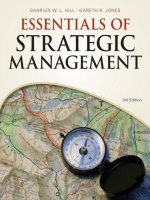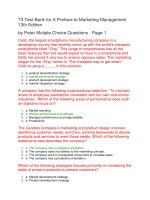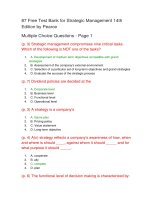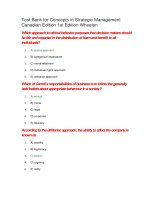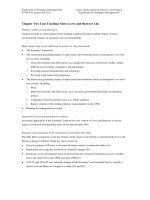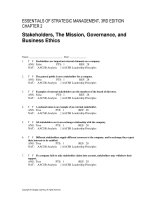Fred r david – strategic management, 13th edition ch10
Bạn đang xem bản rút gọn của tài liệu. Xem và tải ngay bản đầy đủ của tài liệu tại đây (110.74 KB, 31 trang )
Exam
Name___________________________________
TRUE/FALSE. Write 'T' if the statement is true and 'F' if the statement is false.
1)
Leadership is defined as a process of influence that is shared in nature between leaders and followers.
1)
_______
2)
In the Arab world leaders have not had a strong impact on the welfare of societies.
2)
_______
3)
Certain Arab corporations are positioned among the best in the global marketplace.
3)
_______
4)
In formulating and evaluating strategies, leadership has a vital role to play.
4)
_______
5)
The Boston Consulting Group recognized eight Arab companies as being among the top global challengers.
5)
_______
6)
Most Arab executives who have initiated profound changes and built successful corporations have lost
sight of their responsibility towards their business and the future of the region.
6)
_______
7)
According to the GCC's definition, farsighted vision is a short-term outlook that recognizes the importance
of building sustainable institutions for the current generation.
7)
_______
8)
According to the GCC's definition, a willingness to seek ideas from around the world and customize them
for the GCC's unique circumstances is an example of global perspective.
8)
_______
9)
According to the GCC's definition, an example of regional and global perspective is the fact that the GCC's
leaders are not just building their own organizations but are also acting in concert to establish the region
as a global player.
9)
_______
10)
An example of practical openness, according to the GCC's definition, is a willingness to seek ideas from
around the world but only if they reflect cultural ideas which are new to the GCC.
10)
______
11)
The desired qualities that should be nurtured in leaders of the next generation, according to the GCC's
definition, are far-sighted vision, ability to generate profit, and communication skills.
11)
______
12)
The spread of desired qualities in leaders of the next generation can be achieved by communicating the
values and practices shown by successful CEOs in the Arab region.
12)
______
13)
In the Arab region, the successful CEOs have always delegated the shaping of their organizations' culture.
13)
______
14)
In conducting business in the region, Arab executives have sometimes left certain initiatives and actions to
chance.
14)
______
15)
The COO of Mubadala Development Company has commented that his company originally invested for
purely financial returns without a strategic objective.
15)
______
16)
Executives rarely differ in their orientations or in their strategy implementation.
16)
______
17)
In the autocratic form of leadership, there are strict rules and regulations regarding procedures and
coordination.
17)
______
18)
In the autocratic form of leadership, consultation always takes place.
18)
______
19)
In the autocratic form of leadership, sharing of strategic information or coaching of subordinates is not
likely to happen.
19)
______
20)
Benevolent leaders do not set specified rules and policies.
20)
______
21)
The tradition-driven executives are particularly concerned with group harmony.
21)
______
22)
The tradition-driven leaders usually make decisions at the top and centralize control, and maintain
formality in operational aspects and conduct.
22)
______
23)
In tradition-driven leadership situations, subordinates may exhibit commitment to goal implementation
because of their involvement in performance.
23)
______
24)
The spiritually enlightened leaders are guided by ehsan (perfection, excellence) and general Islamic
assumptions.
24)
______
25)
The spiritually enlightened executives are sensitive to their organizational and personal image and monitor
business trends.
25)
______
26)
The spiritually enlightened executives seek input and participation from their subordinates in articulating
their strategic vision.
26)
______
27)
The business scene in the Arab world shows that Arab CEOs do not usually have multiple roles.
27)
______
28)
As part of their strategic managerial roles, most managers in the region are active in securing critical
financial resources and in representing the company to outsiders.
28)
______
29)
Unlike the early generation of executives who depended mostly on intuition, the new executives are
increasingly involved in strategy evaluation.
29)
______
30)
Operations-related managerial roles center on strategy implementation, fair and efficient division of labor,
effective control systems, reward systems, providing feedback, and anticipation of problems.
30)
______
31)
Managers in the Arab world, in the era of global competition, have had to be more willing than their
predecessors to participate in strategic implementation.
31)
______
32)
Managers in the Arab world are generally uncomfortable with leadership activities and roles.
32)
______
33)
In formulating strategy and engaging in implementation, CEOs have to play multiple roles and reconcile
the pressing demands of various stakeholders.
33)
______
34)
Among the most useful indicators of effective leadership is having a succession plan in place for the next
CEO.
34)
______
35)
Having a succession plan shows CEOs are preoccupied with the future and not focused on building a strong
culture immediately.
35)
______
36)
The Arab private sector has always had a tradition of effective succession planning.
36)
______
37)
Since the majority of the firms in the Arab region are family-owned businesses, a smooth transition is
necessary to ensure the survivability and vitality of the business.
37)
______
38)
In the Arab world, there should be a clearly defined process for the selection of a CEO successor.
38)
______
39)
Whether the new CEO is from within or from outside the organization, the role of CEO is similar to other
operating roles.
39)
______
40)
The period between the announcement of the appointment and the actual 'changing of the guard' (the
assumption of responsibility) should be considered a honeymoon period for the new CEO.
40)
______
41)
Business organizations that have sustained growth and achieved remarkable market positions do not
necessarily have a strong organizational culture.
41)
______
42)
The articulation of corporate values enhances loyalty among employees and creates a positive image in
the marketplace.
42)
______
43)
Culture has a minor effect on strategy execution.
43)
______
44)
The founders of an organization are usually the ones who set the tone and vision for the organization.
44)
______
45)
As an organization grows in size and more employees join it, they bring with them their own beliefs and
values, but these don't change the existing culture.
45)
______
46)
In the Arab world, where tradition is deeply ingrained in the mind of the people, employees easily accept
identification with the organizational culture when the leaders are concerned with moral conduct and are
known for their thoughtfulness and inspirational roles.
46)
______
47)
Whilst promoting a strong and positive culture is vital for a company, it does not have much of an affect on
strategy implementation.
47)
______
48)
Strong culture helps to ensure that a company is cohesive and employees have a strong bond with the
company and its mission.
48)
______
49)
Similarly to the West, companies in the Arab world usually deal swiftly with the symptoms of an unhealthy
culture.
49)
______
50)
It is essential that senior managers provide a mechanism to effectively tackle aspects of an unhealthy
culture and prevent the temptation to be complacent.
50)
______
51)
Transparency is not so crucial for safeguarding cultural adaptation and preventing the emergence of an
unhealthy culture.
51)
______
52)
A strong organizational culture is a strategic advantage for an organization.
52)
______
53)
Culture is one of the most critical factors in strategy formulation and implementation.
53)
______
54)
A strong culture helps a company formulate and communicate a coherent strategy, as well as helping to
focus employees' energy throughout an organization into implementing the strategy.
54)
______
55)
Companies that have high divergence between culture and strategy often experience higher performance
and encounter relatively fewer difficulties in implementation.
55)
______
56)
Where existing culture does not smoothly facilitate strategy execution, senior executives face serious
problems.
56)
______
57)
Executives should not give priority to changes that might differ from existing norms and values.
57)
______
58)
Increasingly in the Arab world, corporations have become an influencing factor in economic development
and improving the welfare of the people.
58)
______
MULTIPLE CHOICE. Choose the one alternative that best completes the statement or answers
the question.
59)
The essence of leadership is the ability
59)
______
A)
to articulate vision, organize and deploy resources, and sustain productive involvement and inspirational
performance.
B)
to set a single direction for their organization and ensure everyone adheres to it.
C)
to ensure successful results are delivered, regardless of whether everyone agrees or not.
D)
to articulate vision, delegate the organization of resources, and leave communication to other executives.
E)
to communicate the organization's main purpose and mission, but not to get too involved in strategy
execution.
60)
All of the following UAE based Arab companies were recognized by Boston Consulting Group as being
among the top 100 global challengers, except
60)
______
A)
Agility
B)
Etisalat
C)
Dubai World
D)
Emaar Properties
E)
Emirates Airlines
61)
The Arab companies recognized by Boston Consulting Group as being among the top 100 global
challengers were selected for their
61)
______
A)
ability to create value during economic instability, for their robust revenues and profits, for their hefty
purchasing power, for significant activity in mergers and acquisitions, and for their cautious attitudes
toward risk.
B)
ability to survive during economic instability, for their hefty purchasing power, for making profits without
mergers and acquisitions, and for their bold attitudes toward risk.
C)
ability to create value during economic instability, for their robust revenues and profits, for their hefty
purchasing power, for significant activity in mergers and acquisitions, and for their bold attitudes toward
risk.
D)
ability to make profit during economic stability, for their hefty purchasing power, for significant activity in
mergers and acquisitions, and for their bold attitudes toward risk.
62)
Responsible leaders understand that strategy has two primary objectives. These are
62)
______
A)
to link their corporations to the rest of the market and achieve competitive advantage.
B)
to differentiate their corporations from the rest of the market and have comparative advantage.
C)
to differentiate their corporations from the rest of the market and achieve competitive advantage.
D)
to equate their corporations with the rest of the market and achieve competitive advantage.
63)
All of the following are desired qualities that should be nurtured in leaders of the next generation, except
63)
______
A)
farsighted vision.
B)
practical (pragmatic) openness.
C)
regional and global perspective.
D)
cross-cultural discrimination.
64)
A long-term outlook that recognizes the importance of building sustainable institutions for future
generations is called
64)
______
A)
regional perspective.
B)
farsighted vision.
C)
practical openness.
D)
global perspective.
65)
In the GCC's definition of desirable qualitties for leadership, a willingness to seek ideas from around the
world and customize them for the GCC's unique circumstances is an example of
65)
______
A)
farsighted vision.
B)
regional perspective.
C)
practical openness.
D)
global perspective.
66)
The recognition of the fact that the GCC's leaders are not just building their own organizations but are also
acting in concert to establish the region as a global player is an example of
66)
______
A)
practical openness.
B)
regional and global perspective.
C)
regional perspective.
D)
farsighted vision.
67)
Executives such as Mohammad Omran (Chairman, Etisalat), Ibrahim S. Dabdoub (CEO, National Bank of
Kuwait), Ahmed Heikal (Chairman of Citadel Capital) and Abdel Hamid Shoman (Chairman, the Arab Bank)
are given as examples of people who have
67)
______
A)
been instrumental in shaping the culture of their organizations but have not been able to implement
strategies succesfully.
B)
been instrumental in shaping the culture of their organizations and effective in implementing strategies
that have led these organizations to be credible players in the marketplace.
C)
been fortunate that their organizations have been credible players in the marketplace without any
attempts to shape a strong organizational culture.
D)
mimicked competitor strategies to become credible players in the marketplace.
E)
all the above.
68)
In the Arab region
68)
______
A)
there are numerous examples of how executives have left certain initiatives or actions to chance but no
examples of actions taken with specific goals in mind.
B)
it is impossible to judge whether actions are left to chance or carefully planned.
C)
executives never leave initiatives or actions to chance.
D)
there are numerous examples of how executives have left certain initiatives or actions to chance.
69)
In considering executives' orientations, it is apparent that
69)
______
A)
executives differ in their orientations but rarely in their strategy implementation.
B)
executives rarely differ in their orientations but their approaches to strategy implementation can be very
varied.
C)
executives all have a similar orientation and a similar approach to strategy implementation.
D)
executives differ in their orientations and subsequently in their strategy implementation.
70)
Which of the following is not a form of leadership?
70)
______
A)
Tradition-driven
B)
Commanding
C)
Benevolent (Sheikocratic)
D)
Autocratic
E)
Spiritually enlightened
71)
Benevolent leaders tend to have a centralized authority and are inclined toward all of the following, except
71)
______
A)
placing emphasis on open-door policies.
B)
personal relations.
C)
coaching of subordinates.
D)
caring for the welfare of subordinates inside and outside the organization.
72)
The attitudes of benevolent leaders may induce them to manage business affairs
72)
______
A)
without input from subordinates.
B)
secretively.
C)
formally.
D)
informally.
73)
The tradition-driven executives consider the viability of the organization to be sustained through all of the
following, except
73)
______
A)
involvement.
B)
decentralization of decision-making.
C)
attention to input from subordinates.
D)
coaching.
74)
Spiritually enlightened leaders are guided by deeply held views on the importance of all the following
except
74)
______
A)
The necessity for global expansion.
B)
Giving high priority for the society at large.
C)
Furthering the interest of the community.
D)
The welfare and viability of the community.
75)
The various roles played by Arab CEOs can be grouped into three categories. These include all of the
following except
75)
______
A)
Leadership roles
B)
Micro-managerial roles
C)
Strategic managerial roles
D)
Operationally-related managerial roles
76)
The strategic managerial roles of Arab CEOs include activites that are related to which of the following?
76)
______
A)
Innovation activities
B)
Making critical information available
C)
Setting long-term objectives
D)
Strategy formulation
E)
All the above
77)
The leadership roles performed by CEOs include
77)
______
A)
motivating and inspiring others to action, providing critical information and guidance, clarifying cultural
norms and values, and fostering healthy conflict.
B)
motivating and inspiring others to action, providing critical information and guidance, implementing
effective control systems, and fostering cooperative environments and resolving conflicts.
C)
motivating and inspiring others to action, providing critical information and guidance, clarifying cultural
norms and values, and fostering cooperative environments and resolving conflicts.
D)
motivating and inspiring others to action, securing scarce resources, clarifying cultural norms and values,
and fostering cooperative environments and resolving conflicts.
78)
Which of the following is not a major guide for CEOs in relation to strategy, and especially in strategy
execution?
78)
______
A)
Ensure organizational culture enables planned change.
B)
Exploit societies to achieve goals.
C)
Find the right pace of change.
D)
Do what only a CEO can do.
E)
Engage with boards of directors as strategic partners.
79)
Issues that should be primarily confined to CEOs include
79)
______
A)
monitoring financial performance.
B)
setting performance expectations, accountability, and organizational culture.
C)
making appointments to senior management positions.
D)
planning information technology systems.
E)
all the above.
80)
Unlike most of their counterparts in the west, Arab CEOs face three interwoven challenges. Which of the
following is not one of those challenges?
80)
______
A)
finding appropriate locations from which to operate.
B)
building a thriving economy while being sensitive to political demands and government
intervention.
C)
Meeting social and cultural expectations.
D)
Coping with intense global competition and overcoming hurdles in order to venture abroad.
81)
Which of the following have the pioneer generation of CEOs relied on to establish their businesses?
81)
______
A)
Rich and deep sources of data about their markets.
B)
Gut feelings and unique insights grounded on a keen alertness to emerging opportunities, as well as basic
common sense.
C)
Generosity and shared insights from other CEOs.
D)
Strategic planning.
82)
Which of the following is not a common issue that can complicate power transitions and business?
82)
______
A)
Conflicting interests and priorities.
B)
Rivalry among family members.
C)
Matrimonial relationships among powerful executives.
D)
Reluctance of the founding fathers to nominate a successor.
83)
Which of the following is not a standard activity that companies should pursue in order to increase their
chances of finding a good CEO that will maintain quality performance?
83)
______
A)
The board of directors should be actively involved in the executive search process.
B)
Ensure that there is a pool of trained internal candidates.
C)
Have a succession plan.
D)
The board of directors should allow external recruiters to lead the process.
84)
During the period following the selection of a new CEO, which particular three guidelines are suggested to
help ensure successful transition?
84)
______
A)
Issue a communication that the previous CEO is still in charge in the short term; stay confident but
remember how much there is to learn; alert shareholders to the possibility of a period of turbulence.
B)
All decision making should be done by the board of directors in the short term; ensure the previous CEO
leaves as soon as possible; avoid any strategic decisions.
C)
Make it clear who is in charge; use the interim period wisely; and stay confident but remember how much
there is to learn.
D)
Ensure the previous CEO stays for as long as possible; avoid sending out any press releases during this
period; ensure the new CEO spends time learning about the company.
E)
Avoid making any major changes; send the new CEO on a training course; use the interim period wisely.
85)
Which of the following can be said of a new CEO, regardless of whether they come from within or from
outside the organization
85)
______
A)
A new CEO will always learn faster if they learn independently.
B)
The role of CEO is basically no different from other operating roles.
C)
The role of CEO is different from other operating roles.
D)
A new CEO should always learn everything about their role from the previous CEO.
86)
Which of the following best describes a strong corporate culture?
86)
______
A)
Shared values and beliefs are widely and deeply held.
B)
Employees all need to belong to the same religion.
C)
Lots of different values can coexist.
D)
Conflicts usually get resolved.
87)
Which of the following is not a characteristic of a strong culture?
87)
______
A)
Values and beliefs among members
B)
Ease of absorbing change
C)
Adaptability
D)
Social norms
88)
Employees who consider violating cultural standards
88)
______
A)
represent a healthy expression of creativity which is welcomed by managers.
B)
will experience tremendous pressure from other employees and managers to observe those standards.
C)
will inevitably lose their jobs.
D)
are almost always promoted sooner than employees who adhere to company culture.
89)
Which of the following is not considered a relevant way to sustain organizational norms and principles?
89)
______
A)
Communicate and promote company legends.
B)
Reiterating the roots of the organization.
C)
Acknowledge the contribution of others to the progress and achievement of the organization.
D)
Make sure there is noplace within the company for those who break cultural standards.
E)
Discourage any questionning of organizational priorities.
90)
Which of the following is not a way in which a strategy-culture fit can help a company's strategy
execution?
90)
______
A)
It helps employees feel better about their jobs, the company they work for, and the merits of what the
company is attempting to achieve.
B)
It provides unlimited bonuses, perks, and incentives for the employees.
C)
It directs organizational energy towards effective strategy implementation.
D)
It encourages actions, behaviors, and work practices supportive of effective strategy execution.
91)
Which of the following is not characteristic of an unhealthy culture?
91)
______
A)
Coping with regular change.
B)
Unethical and greed-driven.
C)
Politicized culture.
D)
Insular or inward focus.
92)
Under the conditions of incompatibility between culture and strategy, executives have to consider various
options for managing
92)
______
A)
leader-subordinates relationships
B)
culture-company relationships
C)
manager-line staff relationships
D)
culture-strategy relationships
93)
Leadership and ________ are instrumental for strategy formulation and execution.
93)
______
A)
organizational culture
B)
organizational resources
C)
corporate citizenship
D)
organizational image
ESSAY. Write your answer in the space provided or on a separate sheet of paper.
94)
What are the four forms of leadership?
95)
Describe the importance of leadership and culture in the strategic management process.
96)
Describe the three categories of the evolving role of the CEOs.
97)
Explain some of the rules for successful CEO transitions.
98)
How does corporate culture affect strategy execution?
99)
Outline at least four ways to sustain organizational norms and principles.
100)
What are the characteristics of an unhealthy culture? Quote examples from the companies situated in the
Arab world.
101)
Describe the three ways a strategy-culture fit helps a company’s strategy execution.
102)
What are the various options for managing culture-strategy relationship?
1)
TRUE
2)
FALSE
3)
TRUE
4)
TRUE
5)
FALSE
6)
FALSE
7)
FALSE
8)
FALSE
9)
TRUE
10)
FALSE
11)
FALSE
12)
TRUE
13)
FALSE
14)
TRUE
15)
TRUE
16)
FALSE
17)
TRUE
18)
FALSE
19)
TRUE
20)
FALSE
21)
TRUE
22)
FALSE
23)
TRUE
24)
TRUE
25)
TRUE
26)
TRUE
27)
FALSE
28)
TRUE
29)
TRUE
30)
TRUE
31)
TRUE
32)
FALSE
33)
TRUE
34)
TRUE
35)
FALSE
36)
FALSE
37)
TRUE
38)
TRUE
39)
FALSE
40)
TRUE
41)
FALSE
42)
TRUE
43)
FALSE
44)
TRUE
45)
FALSE
46)
TRUE
47)
FALSE
48)
TRUE
49)
FALSE
50)
TRUE
51)
FALSE
52)
TRUE
53)
TRUE
54)
TRUE
